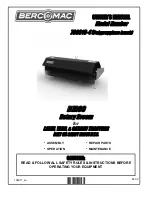
10(18)
Keep all fittings as clean as possible; use the protective caps for the quick
couplings on both the attachment and the loader. Dirt, ice, etc. may make using
the fittings significantly more difficult. Never leave the hoses hanging on the
ground; place them on top of the equipment.
Releasing residual hydraulic pressure:
To make sure that there will not be residual pressure in the hydraulic system of the attachment, shut down
the loader engine and move the auxiliary hydraulics control lever of the loader to it’s extreme positions
before disconnecting the couplings. If the fittings will not connect to the loader, the residual pressure must be
released. The residual pressure must be released before handling or going near the moving components of
the attachment and before storage of the attachment.
5.3.
Uncoupling and storage of the sand spreader
Uncouple and store the spreader on level surface, so that it will
stand firmly on its two outriggers and bottom. Lower the
attachment so that the bottom of the spreader touches the
ground lightly, and set and lock the outriggers into storage
position. Make sure that the spreader will stay stable when
uncoupling it and during storage.
The spreader has supporting stands to keep it in
upright position when it is not attached. Place the
outriggers carefully and secure the locking pin of
the outrigger before unlocking the attachment.
When uncoupling the attachment from the loader, always disconnect the
hydraulic fittings first before unlocking the quick attach plate, to prevent hose
damage and any oil spills. Reinstall the protective caps on the fittings to prevent
dirt from entering the hydraulic system. Set the hoses on the bracket on the
attachment, or onto the top of the attachment; never leave hoses lying against
the ground.
An unmounted spreader may tip
over. Make sure that outriggers are
set properly for storage. Keep a
safe distance to the spreader and
never climb on the spreader. For
the
best
stability,
it
is
recommended to use the spreader
until it is empty, or to empty it
manually before storing it.
NOTICE
NOTICE
Outriggers of the spreader
If placed on uneven terrain or
unlocked without setting the
outrggers first, the spreader
may tip over.
Summary of Contents for A411401
Page 17: ...Sand Salt Spreader 150 2014 1...
Page 18: ......




































